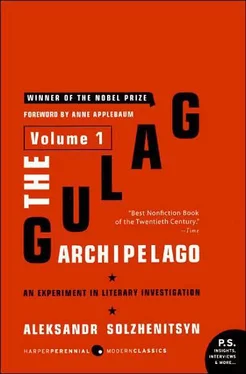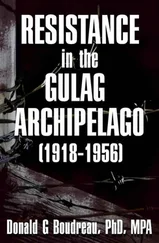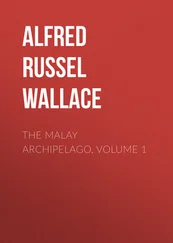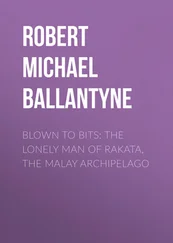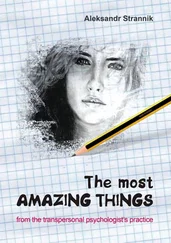So what it comes down to is that all Krylenko and the GPU had to do was select the right people. But the risk was small. Goods spoiled in interrogation could always be sent off to the grave. And whoever managed to get through both the frying pan and the fire could always be given medical treatment and be fattened up, and put on public trial!
So then where is the riddle? How they were worked over? Very simply: Do you want to live? (And even those who don’t care about themselves care about their children or grandchildren.) Do you understand that it takes absolutely no effort to have you shot, without your ever leaving the courtyards of the GPU? (And there was no doubt whatever about that. Whoever hadn’t yet learned it would be given a course in being ground down by the Lubyanka.) But it is useful both for you and for us to have you act out a certain drama, the text for which you, as specialists, are going to write yourselves, and we, as prosecutors, are going to learn by heart… and we will try to remember the technical terms. (Krylenko sometimes made mistakes during the trial. He said “freight car axle” instead of “locomotive axle.”) It will be unpleasant to perform and you will feel ashamed, but you just have to suffer through it. After all, it is better to live. And what assurance have we that you won’t shoot us afterward? Why should we take vengeance on you? You are excellent specialists and you have not committed any crimes and we value you. Look at how many wrecking trials there have been; you’ll see that no one who behaved has been shot. (Mercy for the defendants who cooperated in one trial was an important prerequisite for the success of the next. And hope was transmitted via this chain right up to Zinoviev and Kamenev themselves.) But the understanding is that you have to carry out all our conditions to the very last! The trial must work for the good of socialist society.
And the defendants would fulfill all the conditions.
Thus they served up all the subtlety of engineers’ intellectual opposition as dirty wrecking on a level low enough to be comprehensible to the last illiterate in the country. (But they had not yet descended to the level of ground glass in the food of the workers. The prosecutors had not yet thought that one up.)
A further theme was ideological motivation. Had they begun to wreck? It was the result of a hostile motivation. And now they jointly collaborated in confessing? It was once again the result of ideological motivation, for they had been converted (in prison) by the blazing blast-furnace face of the third year of the Five-Year Plan! Although in their last words they begged for their lives, that wasn’t the main thing for them. (Fedotov: “There is no forgiveness for us. The prosecutor is right!”) The main thing for these strange defendants right at that moment, on the threshold of death, was to convince the people and the whole world of the infallibility and farsightedness of the Soviet government. Ramzin, in particular, glorified the “revolutionary consciousness of the proletarian masses and their leaders,” who had been “able to find immeasurably more dependable paths of economic policy” than the scientists, and who had calculated the tempos of economic growth rate far more correctly. And then: “I had come to understand it was necessary to make a jump ahead, and that it was necessary to make a leap forward, [244]that it was necessary to capture by storm,” etc., etc. And Larichev declared: “The Soviet Union is invincible against the weakening capitalist world.” And Kalinnikov: “The dictatorship of the proletariat is an inevitable necessity.” And further: “The interests of the people and the interests of the Soviet government merge into one purposeful whole.” Yes, and in addition, in the countryside “the general line of the Party, the destruction of the kulaks, is correct.” They had time, while awaiting execution, to deliver themselves of judgments about everything. And the repenting intellectuals even had enough voice for such a prophecy as this: “In proportion to the development of society, individual life is going to become more circumscribed…. Collective will is the highest form.” 28
Thus it was that with eight-horse traction all the goals of the trial were attained:
1. All the shortages in the country, including famine, cold, lack of clothing, chaos, and obvious stupidities, were blamed on the engineer-wreckers.
2. The people were terrified by the threat of imminent intervention from abroad and therefore prepared for new sacrifices.
3. Leftist circles in the West were warned of the intrigues of their governments.
4. The solidarity of the engineers was destroyed; all the intelligentsia was given a good scare and left divided within itself. And so that there should be no doubt about it, this purpose of the trial was once more clearly proclaimed by Ramzin:
“I would like to see that, in consequence of the present trial of the Promparty, the dark and shameful past of the entire intelligentsia will be buried once and for all.” [245]
Larichev joined in: “This caste must be destroyed!… There is not and there cannot be loyalty among engineers!” [246]And Ochkin too: The intelligentsia “is some kind of mush. As the state accuser has said, it has no backbone, and this constitutes unconditional spinelessness…. How immeasurably superior is the sensitivity of the proletariat.” [247]
So now just why should such diligent collaborators be shot?
And that was the way the history of our intelligentsia has been written for decades—from the anathema of 1920 (the reader will remember: “not the brains of the nation, but shit,” and “the ally of the black generals,” and “the hired agent of imperialism”) right up to the anathema of 1930.
So should anyone be surprised that the word “intelligentsia” got established here in Russia as a term of abuse.
That is how the public trials were manufactured. Stalin’s searching mind had once and for all attained its ideal. (Those blunderheads Hitler and Goebbels would come to envy it and rush into their shameful failure with the burning of the Reichstag.)
The standard had been set, and now it could be retained perennially and performed over again every season—according to the wishes of the Chief Producer. And in fact the Chief wanted another within three months. The rehearsal time was very short, but that was all right. Come and see the show! Only in our theater! A premiere.
M. The Case of the All-Union Bureau of the Mensheviks—March 1-9, 1931
The case was heard by a Special Assize of the Supreme Court, the presiding judge in this case, for some reason, being N. M. Shvernik. Otherwise everyone was in his proper place—Antonov-Saratovsky, Krylenko, and his assistant Roginsky. The producers were sure of themselves. For after all, the subject wasn’t technical but was Party material, ordinary stuff. So they brought fourteen defendants onto the stage.
And it all went off not just smoothly but brilliantly.
I was twelve at the time. For three years I had been attentively reading everything about politics on the enormous pages of Izvestiya. I read the stenographic records of these two trials line by line. In the Promparty case, I had already felt, in my boyish heart, superfluity, falsehood, fabrication, but at least there were spectacular stage sets—universal intervention, the paralysis of all industry, the distribution of ministerial portfolios! In the trial of the Mensheviks, all the same stage sets were brought out, but they were more pallid. And the actors spoke their lines without enthusiasm. And the whole performance was a yawning bore, an inept, tired repetition. (Could it be that Stalin felt this, too, through his rhinoceros hide? How else can one explain his calling off the case of the Working Peasants Party after it had already been prepared, or why there were no more trials for several years?)
Читать дальше
